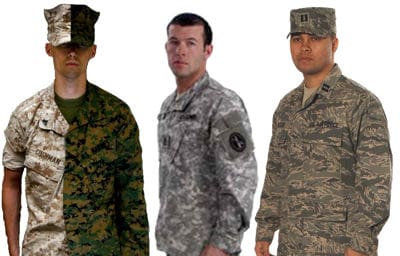In the 2010 House Defense Authorization bill there is a section that would require standard ground combat uniforms.
“Section 352—
Requirements for Standard Ground Combat Uniform This section would require the Secretary of Defense, in consultation with the Defense Logistics Agency, to require that future ground combat uniforms be standardized in order to ensure increased interoperability of ground combat forces and reduce tactical risks encountered when military personnel wear a different uniform from their counterparts in the other military services in a combat area.
The committee notes that, previously all the military services used the same desert camouflage uniform or the standard battle dress uniform, both in the temperate and enhanced weather versions. However, the Defense Supply Center Philadelphia of the Defense Logistics Agency, which is responsible for the manufacture of all U.S. military uniforms, now procures unique camouflage utility uniforms for each of the military services: the Army combat uniform, the Airman battle uniform, the Navy working uniform, and the Marine Corps combat utility uniform.
The committee is concerned that the recent move toward unique service camouflage uniforms has resulted in increased costs and production inefficiencies. For example, problems with consistency in fabric shading have required remanufacture of some uniforms. In addition, the costs for the unique uniforms are substantially more than for the standard battle dress uniform because of the differences in design, camouflage pattern, and type of fabric.
Most importantly, the committee is concerned that this uniqueness poses a tactical risk in theater, especially for those assigned to combatant commands or as individual augmentees who may be wearing a different uniform from those they are serving with in combat.
The committee also notes that service-specific battle dress uniforms magnify the challenges and costs associated with procuring personal protective gear and body armor that conform to the design and coloration of the basic uniform”
Well, Congress pretty much hit the nail on the head, just six years too late. This horse has been out of the barn for awhile but it does seem that the hoopla over the Army’s use of UCP in Afghanistan has attracted some thoughtful analysis. Interestingly, these are essentially the same arguments made by Robert Strange McNamara when he was Secretary of Defense during the Kennedy administration. At his direction, in the early 1960s the services moved to a standard uniform including boots and at one point, even T-shirts. However, this proposed legislation also references an issue that has been a major concern in the field and that is fratricide and OPSEC.
The services rely heavily on their individual uniforms for branding purposes so it is unclear how the departments may react to such a directive. Although, according to the document, there is some wiggle room including a reference to “future ground combat uniforms” which might allow the services to delay any changes to coincide with the fielding of future individual equipment ensembles. Another issue is that the bill references both utility uniforms as well as combat uniforms. Interestingly, Army, Air Force, and Marine Corps have all adopted FR combat uniforms that closely resemble one another except in the area of camouflage. The real differences come to play in the utility uniform realm. Such distinctions might make implementation difficult.
There have been calls within industry for some time for the services to adopt a single color scheme in order to simplify production and realize cost savings. While the implications of such legislation are very deep for the military as well as industry, it is important to note that this is still just a bill and not yet law. In fact, it may not even make it out of committee.
Thanks to ADS Ventures for alerting us to this legislation. It will be interesting to find out who is promoting this particular measure.



[…] no one has fessed up to backing the proposed legislation requiring a common camo pattern and combat uniform for all US forces, some in Congress have made […]